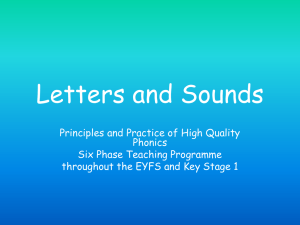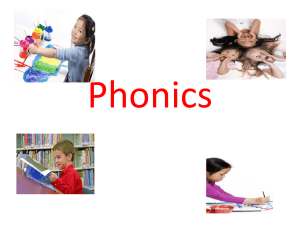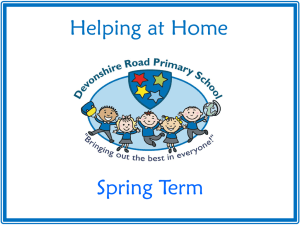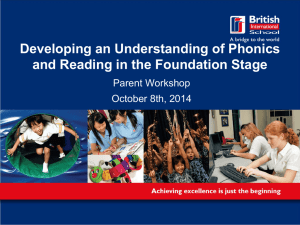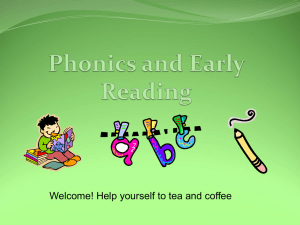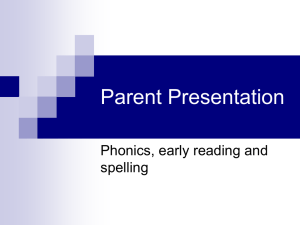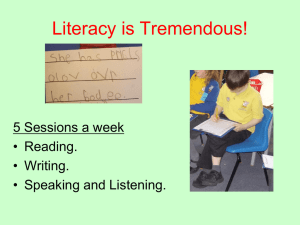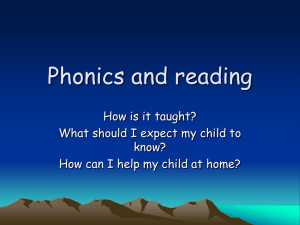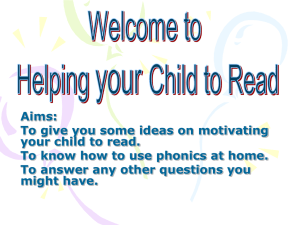Fun with Phonics powerpoint - Leavening Community Primary School
advertisement
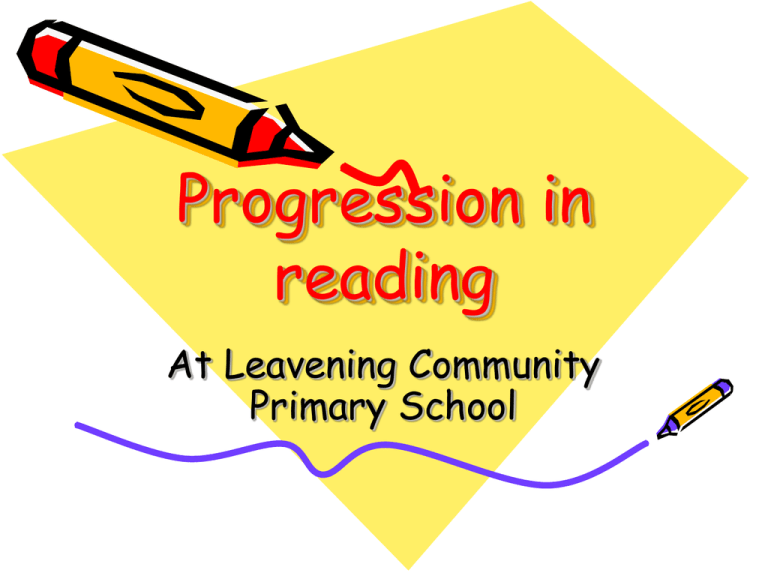
Progression in reading At Leavening Community Primary School Our lesson this morning… • Introduction and background to how we teach early reading(phonics through to reading in KS2). • Phonics quiz!! • An overview of the progression in phonics from Early Years through to year 6 • Activities – what goes on in a phonics lesson? • Reading across school • Questions and answers Our aim of this morning are… • to provide you with an insight into the teaching of and progression of phonics and reading here at Leavening CP School. An overview of the phases in phonics: Phase 1 – Recognising sounds in our environment, with musical instruments and using body percussion. Learning about rhythm and rhyme, as well as sharing stories and books. Phase 2 – Children begin to learn that letters have sounds. They put these together to make simple words (vc and cvc) and practise writing, reading and spelling. They begin to learn some high frequency words and tricky words. Phase 3 – Children learn another 25 graphemes, most of them are made up of 2 letters. They continue writing, reading, spelling and putting together the graphemes to make words. Phase 4 – Children will consolidate children’s knowledge of graphemes in reading and spelling words. Phase 5 – Children will further their understanding and use of graphemes and phonemes. They learn that there are alternative ways of pronouncing graphemes and need to choose the correct one when it comes to spelling. Phase 6 – This is where we are all working! At this stage, children consolidate their learning from the previous phases. They begin to learn about prefixes, suffixes and the past/present tense. Phase 1 made up of seven aspects (EIBRAVO) • environmental sounds • instrumental sounds • body percussion • rhythm and rhyme • alliteration • voice sounds • oral blending and segmenting children learn… • awareness of rhyme and alliteration • to distinguish between different sounds in the environment and phonemes • to explore and experiment with sounds and words • to orally blend and segment phonemes • this phase lays the foundations that are needed for the next phase • children in nursery will be working through this phase • children engage in adult-led activities that help develop oral blending and segmenting of the sounds of spoken words EXAMPLE parents can join in later Phase 2 • falls largely within the literacy area of the new EYFS curriculum children are learning how to… • hear and say the initial sound in words • segmenting the sounds in simple words and blending them together • link sounds to letters • read irregular words (tricky words) • this phase is made up of 19 letters of the alphabet each with its own sound they are… • satpinmdeurhbgockfl • blending separate sounds together into whole sounds for reading • segmenting whole words into separate sounds for spelling • blending to read simple captions • tricky words are… • the, to, no, go, I each lesson should last only twenty minutes and is delivered in four sections… • recap/revisit • teach • practise • Apply http://www.focusonphonics.co.uk/sound.htm Phase 3 • By the time they reach Phase 3, children will already be able to blend and segment words containing the 19 letters taught in Phase 2. • Over the twelve weeks which Phase 3 is expected to last, twenty-five new graphemes are introduced (one at a time). • Set 6: j, v, w, x • Set 7: y, z, zz, qu • Consonant digraphs: ch, sh, th, ng • Vowel digraphs: ai, ee, igh, oa, oo, ar, or, ur, ow, oi, ear, air, ure, er • During Phase 3, children will also learn the letter names using an alphabet song, although they will continue to use the sounds when decoding words. • Tricky words • During Phase 3, tricky words (which can't yet be decoded) are introduced: • her Phase 4 • When children start Phase Four of the Letters and Sounds phonics programme, they will know a grapheme for each of the 42 phonemes. They will be able to blend phonemes to read CVC (consonant-vowel-consonant) words and segment in order to spell them. • Children will also have begun reading straightforward two-syllable words and simple captions, as well as reading and spelling some tricky words. • In Phase 4, no new graphemes are introduced. The main aim of this phase is to consolidate the children's knowledge and to help them learn to read and spell words which have adjacent consonants, such as trap, string and milk. Phase 5 • Children broaden their knowledge of graphemes and phonemes for use in reading and spelling • Learn new graphemes and alternative pronunciations some of which they will have already encountered in high frequency words • Learn to choose the appropriate graphemes when spelling and begin to build up word specific knowledge New graphemes for reading Alternative pronunciations Phase 6 • Phase 6 is all about enabling children to become fluent readers and spellers. • Children remain in Phase 6 for the rest of their primary school career maybe longer – or forever! • Support for spelling Areas covered Identifying the tricky bit in a word. Develop strategies for spelling longer words. Develop guidelines for making choices between spelling alternatives. Begin to explore spelling conventions e.g. when using the past tense, adding suffixes Teaching or reading V Practising reading Guided reading Shared reading Cross curricular reading Changing books routine Parents role Reciprocal Reading …the next steps….. Activities What your child would do in a phonics lesson… What can you do to help your child’s reading development? •Be prepared to spend some time with your child, sharing a book, ANY book, for 10 minutes each day! •Read anything and everything! •Help practise reading, spelling and writing the words in their word kit packs. •To support comprehension- do reciprocal reading •Play sound recognition games with your child, such as “Eye Spy” and “Guess the word”. •Be patient Children develop at different paces! •Make it fun. Learning to read shouldn’t be a painful experience for you!!!! Thank you for your continued support in your child’s education. We really value your efforts…..
